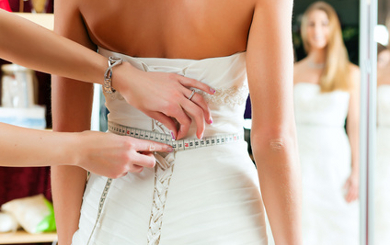Second Hand Wedding Dresses – What to Look For
A wedding dress is the pinnacle of a girl’s dream wedding, it encompasses everything that her wedding should be. Whatever your dream, there’s a dress to match; princess, old school slinky, fairytale, big, small, wearing your Mum’s or even your Grandma’s, the only rule is that your dress should reflect you and your wedding theme.
Wedding dress styles have changed throughout the years and each decade has it’s own distinct silhouette. Nowadays buying second hand dresses has lost much of the stigma that used to be attached and if vintage or recycling is something you feel passionate about there are plenty of sources available for finding the perfect second hand dress.
Wish List
Before you start searching, it’s worth putting together a wish list of things you’d like from your dress. Much of this list will mirror someone who’s buying brand new; style, sleeves, colour, fabric. But there are some things that need to be considered that only come with buying a second hand dress.
Given the variety of styles out there, research a few looks before buying, your mind might be changed after you see a few pictures. Just because you’re after full length doesn’t mean that tea length (just above the ankles) isn’t something you’ll also love. Having more options on style will give you greater choices on dresses available to you in your area and in your size.
Alterations & Repairs
 Consider bribing anyone you know that’s handy with a sewing machine. There’s a possibility that your second hand dress may need some repairs, particularly if you’re on a strict budget. Dresses that have rips in their seams or holes in the lace will be priced lower to reflect that and shouldn’t be dismissed out of hand. Small repairs and additions such as cap sleeves can easily be made by someone with a little skill.
Consider bribing anyone you know that’s handy with a sewing machine. There’s a possibility that your second hand dress may need some repairs, particularly if you’re on a strict budget. Dresses that have rips in their seams or holes in the lace will be priced lower to reflect that and shouldn’t be dismissed out of hand. Small repairs and additions such as cap sleeves can easily be made by someone with a little skill.
If you know someone with a lot of skill, then major alterations won’t be such a problem. Removing several inches from the bottom of your dress to suit your petite size should be a cinch for them, and if it’s something that needs to be done regularly to your skirts and dresses then look for a style with an easy to alter hem. Wedding dresses are traditionally made long but a second hand dress may already have been altered and anything with decoration around the bottom will either need to be moved or removed which can change the look of your gown.
If you can, always try on the dress first, or make sure you fix a price that you’re happy to pay and still have no dress if what you end up with doesn’t fit you. Remember seams can be opened slightly depending on the seam allowance, or dresses can be taken in, but you’re better off having someone who knows what they’re doing making those kinds of alterations and that may mean paying a seamstress.
Don’t be put off by small discolourations, yellowing due to age or rust spots. There are plenty of tutorials online that cover how to deal with these problems but be aware that they can’t always be removed completely. Make sure your dress has no imperfections in prominent places or plan to use brooches, ribbon or flowers to cover them.
Sizing
Finally, when looking at dresses from previous decades always, always ask for flat measurements if you can’t try it on. Sizing has changed dramatically over the decades and depending on the era you can be a size 12 in modern terms but a size 18 in the 1940’s. The only way to be sure the seller is speaking the same size is to get measurements and compare them to your own.
Whatever style you choose, a second hand dress will not only offer you a unique look on your wedding day but will often be cheaper and, in some instances, better quality than anything you can get on a budget brand new.
